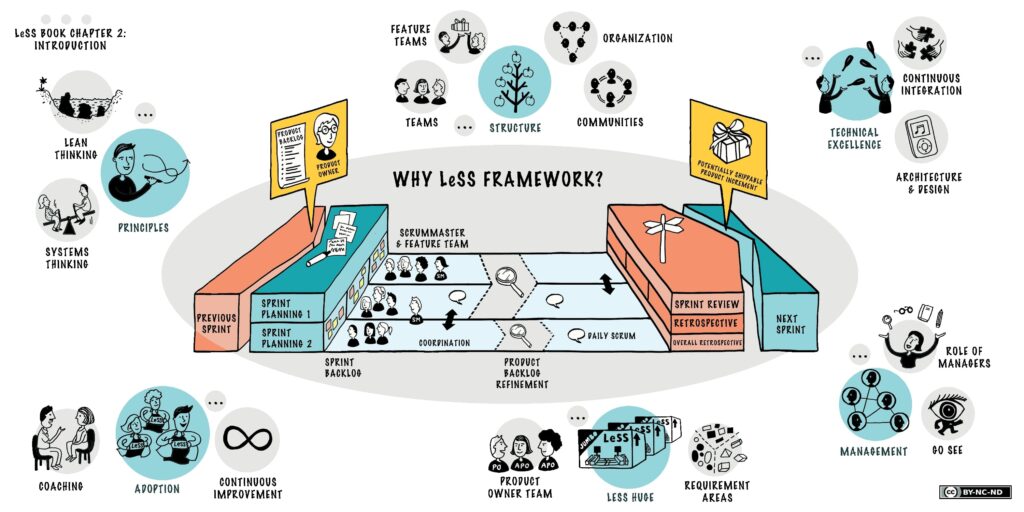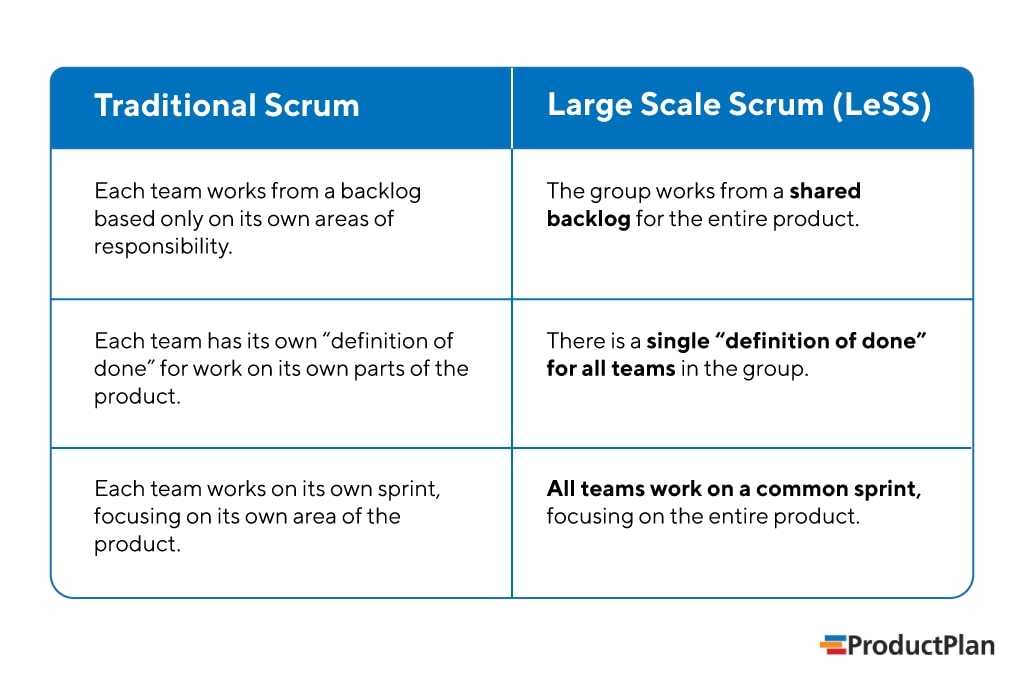Large Scale Scrum (LeSS) uses the principles of Scrum in a large-scale context where multiple teams collaborate to produce one shippable product.
Like single-team Scrum, the LeSS framework includes product owners, managers, scrum masters, and scrum teams. Teams use a customer-centric approach when deciding on the various features to include during Sprint Planning sessions to deliver a successful product.
There are two types of Large Scale Scrum; Basic LeSS and LeSS Huge. Basic LeSS is similar to single-team Scrum and works best for two to eight teams (between 10 and 50 employees).
LeSS Huge focuses on big projects where more than eight Scrum teams (anywhere over 50 employees) work together to deliver a single shippable product.
This article looks at what Large Scale Scrum is, the essential components thereof, and what its benefits and drawbacks are.
What is Large Scale Scrum (LeSS)?
Large Scale Scrum, or LeSS, is a scaled agile framework that enables you to adopt and implement Scrum at a large scale.

Credits: Less.works.com
The LeSS framework employs Lean Thinking and Systems Thinking, among other principles and techniques, to keep the framework and overhead as light as possible while still guiding you through key decisions.
So, what makes the LeSS framework tick? It employs an inclusive strategy that encourages workplace collaboration amongst teams.
LeSS is Scrum for multiple teams working on the same product. These are cross-functional teams that all serve the same purpose. Teams decide which feature to work on based on strengths across all teams. They strive for continuous integration of features and continuous delivery of shippable products.
An essential component of Large Scale Scrum (LeSS) is the implementation of Product Backlog Refinement Meetings (PBR). Through a series of concurrent sprint executions, PBR sessions broaden sprint planning across all areas of focus.
Product Backlog Refinement meetings are crucial for teams to understand, discuss and refine features to prepare for upcoming Sprints.
Large-Scale Scrum vs Scrum
It’s important to note that even though LeSS is for large companies, it still preserves Scrum’s basic principles.

Credits: Product Plan
Scrum is a simple framework that exposes organizational design flaws and lets you address complex problems associated with product development through empirical process control and continuous improvement.
As an agile process, Scrum involves teams working together to build a product in an iterative manner. Agile teams are self-managing, cross-functional groups tasked with generating a shippable product by the end of each Sprint.
A Sprint is a 1-4-week period during which a small Scrum team collaborates to improve their product with the addition of new features.
The Product Owner is in charge of optimizing the product’s value and creates a list of priorities based on the Sprint goal before each Sprint. The Sprint Backlog, which is a list of possible features requested by customers, determines priorities. The Product Owner determines the value of each feature and has the authority to refuse features.
The Scrum Master advises the Product Owner and coaches the Scrum team on agile principles. They are in charge of guiding the product development teams throughout the entire process.
The LeSS framework is not a new and improved version of Scrum. In fact, LeSS is an extension of it. This is because LeSS still utilizes the same principles in basic Scrum to scale Scrum processes in large organizations.
Essential Components of Large Scale Scrum (LeSS)
Large Scale Scrum consists of principles, guides, frameworks, rules, and experiments.
Numerous experiments on scaling Scrum forged the key elements of the LeSS framework. These elements all tie together to assist large organizations in large-scale product development.
Principles
The LeSS framework has 10 principles that it lives by. The principles teach you how to apply Large Scale Scrum and assist in decision-making throughout the process.
- Large-Scale Scrum is still Scrum: LeSS is about determining the most straightforward way to implement Scrum’s concepts, rules, elements, and purpose in a large-scale setting.
- Empirical Process Control: This entails using retrospectives to examine and adjust the product, processes, behaviors, organizational design, and practices on a regular basis to ensure that they continue to evolve.
- Continuous improvement in the pursuit of perfection: LeSS urges teams to create and deliver products that delight customers, help the environment, and improve people’s lives with little cost and no flaws. To achieve that goal, conduct a never-ending series of incremental and bold improvement trials. Perfection isn’t attainable, but your Scrum team must have the mindset that they are moving towards it by working together.
- Whole product focus: Regardless of whether there are 2 Scrum teams or 20 Scrum teams, there is one Product Backlog, one Product Owner, one shippable product, and one Sprint. Customers want essential functionality in a single product, not distinct technical components.
- Customer-centric approach: Understand and resolve your clients’ true problems. Determine what is valuable and what is not in the view of paying customers. Develop and reinforce feedback loops with actual customers. Everyone must recognize how their day-to-day work affects customers.
- More with less: Teams with fewer roles have more authority and responsibility. LeSS simplifies the process with fewer artifacts, which supports a focus on customer value. Fewer processes encourage learning and accountability among all teams.
The LeSS framework thrives on more responsible teams that focus on the customer and generate meaningful work. LeSS aims to make large-scale product development as simple as possible. - Lean thinking: Create an open space where all the teams learn the practice of lean thinking. Team leaders must teach their teams to focus on customer value and reduce waste/defects. Teams work to challenge the status quo of standard Scrum rules and focus on major areas for improvement.
- Systems thinking: Visualize, understand, and optimize the entire system. Teams use systems modeling to investigate system dynamics and avoid local sub-optimization like focusing on the performance of individuals. Customers care about the overall flow of the cycle, not individual processes.
- Queuing theory: Understand how systems with queues perform in the development process and apply those insights to queue sizes, work-in-progress restrictions, multitasking, and variation.
- Transparency: Focus on “done” items, short cycles, teamwork, shared definitions, and eliminate mistrust in the workplace.
Guides
LeSS guides are suggestions based on LeSS experiments created by Craig Larman and Bas Vodde. They are useful in determining how to implement LeSS, the responsibilities of the people involved, and how to organize teams.
Keep in mind that the guides are recommendations and not rules when using the LeSS framework.
Frameworks
Large Scale Scrum divides into two categories: Basic LeSS and LeSS Huge. Basic LeSS works best for up to eight teams and is similar to one team Scrum (between 10 and 50 employees).
LeSS Huge starts with more than eight Scrum teams (more than 50 people) collaborating on large projects to develop a single product. It incorporates the Basic LeSS framework and introduces new roles, more artifacts, and meeting changes.
This critical role introduced in LeSS is an Area Product Owner (APO). The Area Product Owner supports and organizes with the overall Product Owner, and is crucial in bridging the gap between commercial needs and technical teams.
The Area Product Owner performs the same tasks as the Product Owner, but with a narrower scope and focus on the team they serve. The Area Product Owner specializes in customer-centric work and serves as the Product Owner for feature teams.
Experiments
The authors of LeSS, Craig Larman and Bas Vodde, include experiments that they recommend some organizations pursue and others avoid. Experiment results were crucial in the development of the LeSS framework.
Larman and Vodde framed Large-Scale Scrum as a set of experiments and noted that there are no such things as best practices in LeSS frameworks since best practices are subject to their environment.
Roles in Large Scale Scrum
LeSS doesn’t require Team Leads or Project Managers. Their responsibilities fall to the Product Owner. The Scrum Master assists Product Owners in decision-making and teaches Scrum teams the value of Scrum.
Scrum teams or Feature teams do the actual work of developing the product during Sprints. Teams hold a Sprint Review meeting after each Sprint to analyze the changes they made to the product.
Product Owner
A single Product Owner oversees all Feature teams and provides them with work through a single Product Backlog.
The Product Owner has a Product Owner team, which consists of other Product Managers. Together they form Product Management which focuses on maximizing the value of the product.
LeSS Huge has an Area Product Owner who focuses on one major feature area.
Scrum Master
Scrum Masters work full-time in LeSS. They serve up to 3 teams and guide them through the product development process. Scrum Masters work with Product Owners to get the best out of Feature teams.
Scrum Teams
Scrum teams or Product groups plan and execute features based on priorities given to them by their Product Owner.
The Product group performs a daily Scrum during Sprints where they discuss the progress of their work and plan the upcoming work day. Teams also use Sprint Review meetings to examine their work and set Sprint goals for their next Sprint.
Benefits and Drawbacks of Large Scale Scrum
Benefits
- Easy to implement for many organizations already using Scrum since LeSS builds on Scrum principles.
- The Product Owner understands the LeSS principles and framework. They communicate with both business and technical teams.
- LeSS has a simple framework with fewer people needed to deliver a final product.
- The Feature teams have a customer-centric approach and develop products based on their feedback.
- Overall retrospective meetings enable continuous improvement throughout the development process.
- Large organizations that use the LeSS framework have a whole product view because all teams work together for the same purpose.
Drawbacks
- Scaling Scrum requires training. Companies that haven’t used Scrum before struggle to adopt it the first time around.
- Organizations that want to implement a scaled agile framework like LeSS need to make major changes to their organizational structure. This means changing personnel and positions which slows down productivity for established companies.
Product leaders recommend implementing LeSS in small increments by starting off with introducing standard Scrum rules first and then building on them to suit the size of your organization. - Scrum requires small, cross-functional teams to function. It is difficult to build the right Scrum team because you need to find individuals who don’t specialize in one field but have experience in a range of duties.
Large-Scale Scrum Framework: Key Takeaways
Large Scale Scrum is beneficial to large organizations that struggle with scaling Scrum. LeSS provides a helpful framework that assists companies to develop products with a customer-centric approach in large, ongoing projects.
Although LeSS is similar to one team Scrum, it’s important to understand the key differences that distinguish it as one of the leading frameworks for scaling Scrum.
The addition of an Area Product Owner and Product Backlog Refinement meetings pave the way for large organizations to deliver shippable products to their clients. However, implementing LeSS doesn’t happen overnight.
Companies that want to get the most out of LeSS must do so by introducing the new framework in stages. Once adopted, it’s a sure recipe for success.